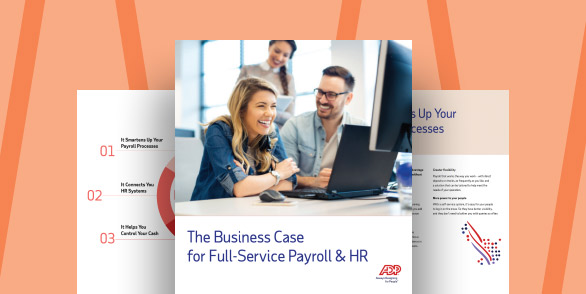Every business, large and small, that employs people has one thing in common – they all must manage payroll in some way. Due to the complexity and importance of the task, many employers choose to work with a payroll provider to help ensure that it’s done right. In fact, the term “managed payroll” actually refers to a type of business process outsourcing, wherein a third-party provider handles all payroll administration on behalf of the business.

Why manage payroll?
Employers must manage payroll so that their employees are paid correctly and on time and their business complies with all tax and employment regulations. Choosing a payroll service provider for this purpose has several benefits, including:
- Improved accuracy
Payroll software can automate many manual processes to reduce the risk of miscalculations, missed payments or other mistakes attributable to human error.
- Robust reporting
In the event of an inquiry from a tax agency, employers can typically run reports across all aspects of their payroll – wages paid, taxes withheld, taxes paid, etc. – to comply with the request.
- Time savings
Not having to manage payroll on their own affords employers the ability to focus more of their attention on strategic, growth-oriented objectives.
How to manage payroll
Regardless of how an employer chooses to manage payroll, there are several basic steps that apply to most methods:
- Collect and update employee data
Social Security numbers, tax withholding certificates, benefit enrollment deductions and worker classifications are just some of the information needed for every employee.
- Calculate gross pay
To calculate gross pay for non-exempt or hourly workers, employers will need to track the total hours that employees work and multiply it by their hourly rate. The process is a bit easier for exempt, salaried workers. Simply, divide the annual salary by the number of pay periods.
- Calculate net pay
Net or take home pay is calculated by first deducting any pretax contributions to benefits or retirement plans from gross pay. Next, withhold federal income tax, Federal Insurance Contribution Act (FICA) taxes and any other state or local taxes and withholdings that apply. Finally, make post-tax deductions, if necessary, for some types of benefits, retirement plans and wage garnishments.
- Determine employer payroll tax contributions
Employers are responsible for paying half of the FICA tax total, as well as federal and state unemployment taxes. There may be other state and local payroll taxes, depending on the particular state or city.
- Keep accurate payroll records
The federal government mandates that businesses save their payroll records for at least three years. Some states have even longer requirements.
- Pay employees
Businesses generally have their choice of paying employees by paycheck, direct deposit or paycard, although some states have regulations regarding offering electronic and alternative pay.
- Pay government agencies and benefit providers
The taxes, benefits and garnishments withheld from employee wages, along with employer contributions to payroll taxes and insurance premiums, must be sent to the appropriate agencies and insurance carriers on time.
- File tax reports
Businesses are required to report the taxes they withheld and paid to federal and state governments. This is typically done either quarterly or annually, depending on the business’s total tax liability and state regulations.
Things to consider when managing payroll
Before deciding to manage payroll with a service provider, employers may want to consider their priorities and ask themselves these questions:
- When it comes to processing payroll, what are the scarcest resources?
Limited time and lack of staff are common reasons that employers seek help with payroll.
- What are the greatest pain points when managing payroll?
Some employers have trouble getting payroll calculations accurate, while others may struggle with employment law and tax compliance.
- What is the preferred method for employees to access their pay and benefits information?
A business owner or HR manager may field these types of requests, but most employees today prefer self-service, a feature that’s common with payroll software.
- Going beyond payroll, what services will the business need help with?
As businesses grow, they may need additional features, like time and attendance, benefits administration or HR services. Many providers are capable of integrating these capabilities with payroll.
- How confident is the current payroll administrator with researching, calculating and filing taxes?
Some full-service payroll providers will file taxes on behalf of their client and help them with regulatory compliance.
Tips for managing small business payroll
Managing payroll is a skill that many small business owners often learn too late. By following these tips, however, they may be able to improve their process and run payroll the way larger organizations do:
- Create a payroll calendar
Payroll calendars help employers keep track of important due dates so they can pay their people and their taxes on time.
- Make payroll policies available
Employee engagement may improve by letting everyone know the company’s payroll policies, such as how wages are calculated and mistakes corrected.
- Record best practice procedures
Creating a manual with all the preferred steps for managing payroll can help administrators better understand and fulfill their responsibilities.
- Integrate payroll with timekeeping
Time and attendance software tracks how many hours employees work so that employers know when to apply overtime rates and can accurately calculate hourly wage earnings.
- Open a separate payroll bank account
Employers that use the same bank account for payroll and business expenses sometimes find themselves unable to pay their employees or their taxes when money is tight.
- Stay current with the latest regulations
Being unaware of a new tax law or an update to an existing regulation puts businesses at risk of being noncompliant.
- Hire an experienced payroll administrator
Having a payroll administrator on staff who is detail-oriented, organized and good at analyzing numbers can help minimize costly mistakes and penalties.
- Conduct payroll audits
Payroll audits, when conducted at least once year, can help spot errors and identify areas where the process needs improvement.
- Consider a co-employment arrangement
Employers who want to minimize risk as much as possible might consider joining a professional employer organization (PEO), which generally will handle most aspects of payroll, among other responsibilities, on their behalf.
Frequently asked questions about managing payroll
What is a payroll management system?
A payroll management system is software technology designed to make running payroll easier for businesses. It automates many of the most labor-intensive processes, such as calculations, deductions and payments, and in some cases, includes tax reporting services and compliance support. Many providers today offer payroll management as a standalone product or as part of a larger suite of integrated HR capabilities.
What is meant by pay management?
Pay management generally means the process by which businesses pay their employees and file payroll taxes with government agencies. The term is also sometimes used to refer to payroll outsourcing services.
What are some payroll best practices?
One of the surest ways for employers to improve their payroll processes is to work with a service provider. Short of that, these three best practices, although basic, may prevent a lot of headaches for those who are new to payroll or still using DIY methods:
- Update payroll records regularly with the latest details for each employee
- Double-check all work that requires data entry for duplicate information and mistakes
- Create a system of reminders to help avoid missing a tax deadline
This guide is intended to be used as a starting point in analyzing an employer’s payroll obligations and is not a comprehensive resource of requirements. It offers practical information concerning the subject matter and is provided with the understanding that ADP is not rendering legal or tax advice or other professional services.






